Is it worth visiting Benalmadena Pueblo?

Benalmadena Pueblo is part of Benalmadena, a town in the Costa del Sol, in the province of Malaga. It is one of the 3 districts of Benalmadena – the other two being Benalmadena Costa and Arroyo de la Miel. Benalmadena Pueblo is also known as Rancho Domingo and as Benalmadena Old Town.

The development of Benalmadena Pueblo has little to do with the rise of the rest of the town. This Pueblo blanco’s occupation dates back to the neolithic times; the wall (Muro) that today surrounds the main church (Iglesia de Santo Domingo de Guzmán) was erected by the Muslims, sometime between 700 and 1200 AD.
The church of Santo Domingo de Guzmán dates from the XVII century, built in a location that combines the safety of the high grounds with the possibility to see ahead the advance of potential enemies by sea. The Pueblo that exists today probably dates back to the time the church was first built.

Benalmadena became a tourist location much later, around the 1960s, following the development of Torremolinos as a destination. That’s why you can barely tell the borders between Arroyo de la Miel (in Benalmadena) and El Pinillo or La Leala (in Torremolinos) or between the Puerto Marina, in Benalmadena Costa and La Carihuela, in Torremolinos.
Benalmadena Pueblo, on the other hand, remains to this day a bit of a remote location, separated from the other two areas by stretches of land with sparse houses. That probably helped keep the traditional atmosphere of a charming village in the Pueblo.
Is Benalmádena Pueblo worth visiting?
Yes, without a doubt. This is the most traditional area of the city, a Pueblo Blanco inside a town. Walking around you can find the traditional flowers pots outside, the cute squares that appear by surprise through the winding roads, along with outstanding sea and mountain views.
In Benalmadena Pueblo you can enjoy the traditional Spanish lifestyle with stops to eat some tapas. Not only it is a gorgeous little pueblo, it is also the closest-to-the-sea traditional Pueblo in the whole Costa del Sol. And getting there is easy! Despite its relative remoteness, the public transport connection with the rest of Benalmadena and with Mijas makes getting there a breeze.

What to see in Benalmádena Pueblo / Benalmadena Old Town?
Calle Real (Royal Road)
The beautiful Calle Real is a walk-only street lined by white houses, palm trees and flowers. There are many cafes and restaurants along this small road, which makes it a great stop before reaching the Plaza de España.

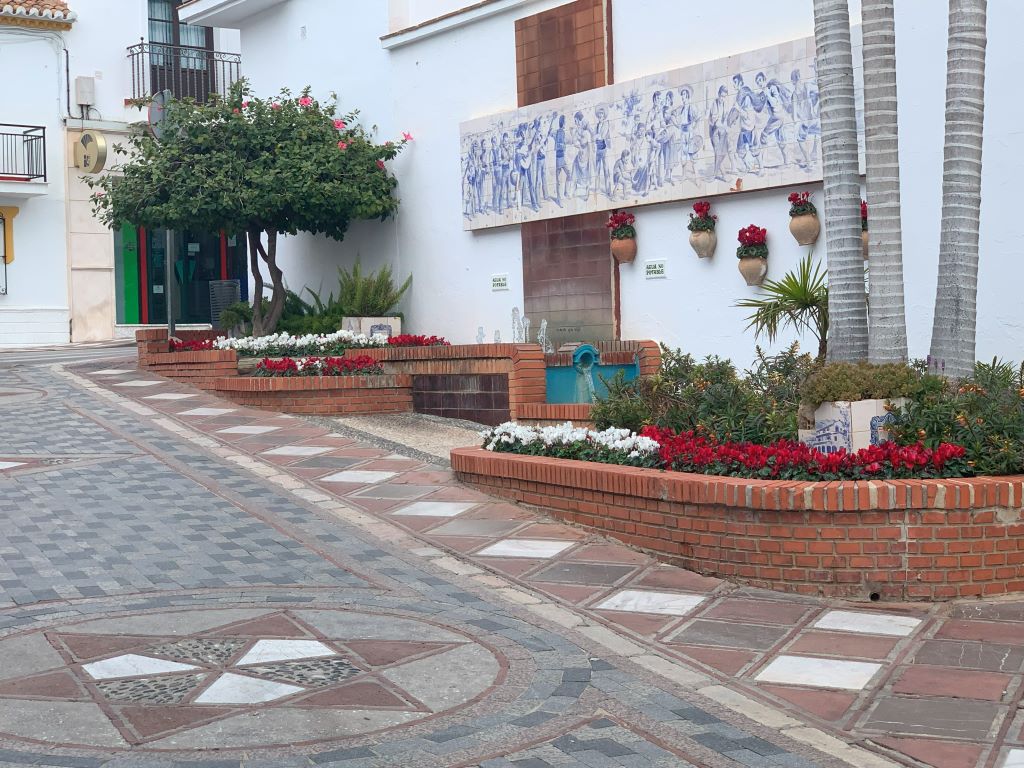
Plaza de España
At the end of Calle Real you’ll find the central Square of Benalmádena Pueblo, Plaza de España, with the statue La Niña de Benalmádena (Benalmádena girl), one of the symbols of Benalmadena.

Around this cute square there are also many places to eat, rest and enjoy the views.

Moving along from the Plaza de España through Calle Santo Domingo, a small walk-only street, you’ll soon get to the Church of Santo Domingo de Guzmán.

Church of Santo Domingo de Guzmán
The Church of Santo Domingo de Guzmán was built in the XVII century but has been renovated recently. This is the main church of the Pueblo, surrounded by gardens that offer a great view of the coast.
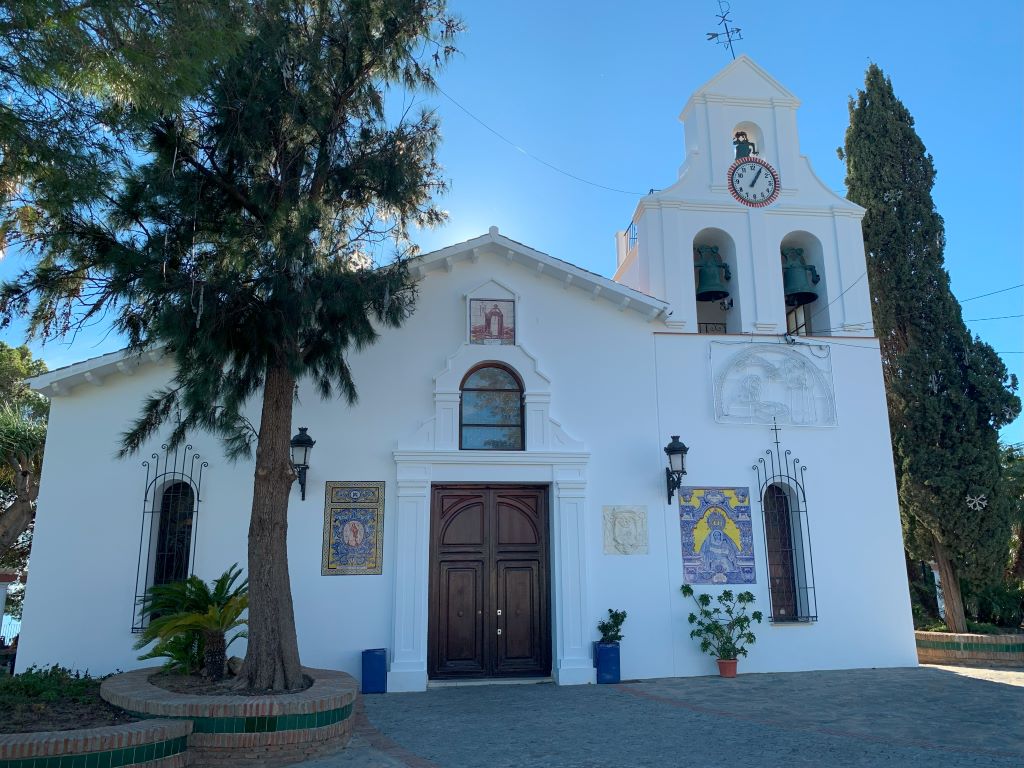

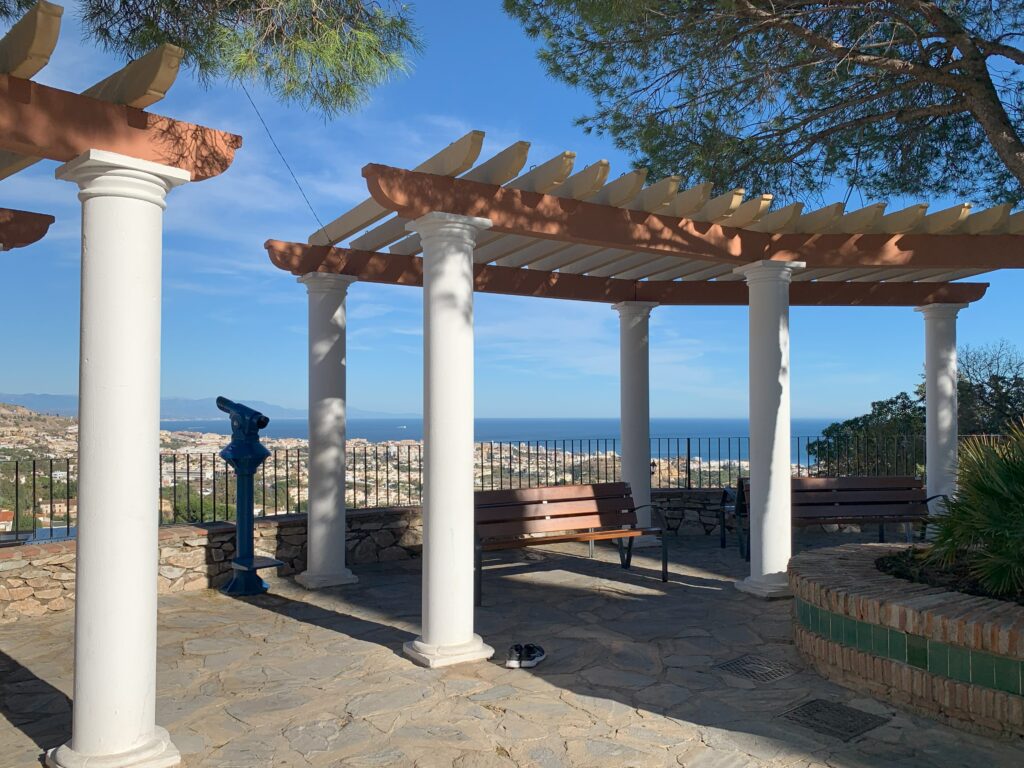
Jardines del Muro (wall gardens)
While at the Church of Santo Domingo de Guzmán, take your time to go around the garden enjoying the amazing panoramic views Benalmadena Pueblo offers.

You’ll find some gates around the gardens. They are usually closed during special celebrations, as it would be difficult to guarantee the safety of people wandering down the different layers of the gardens along the wall – people could get lost here! But if you happen to be luck like I was the last time I went to the Pueblo (!) and find these gates open, wander a bit down. 😉 Here, some pictures of places that you (literally) can’t see every day:



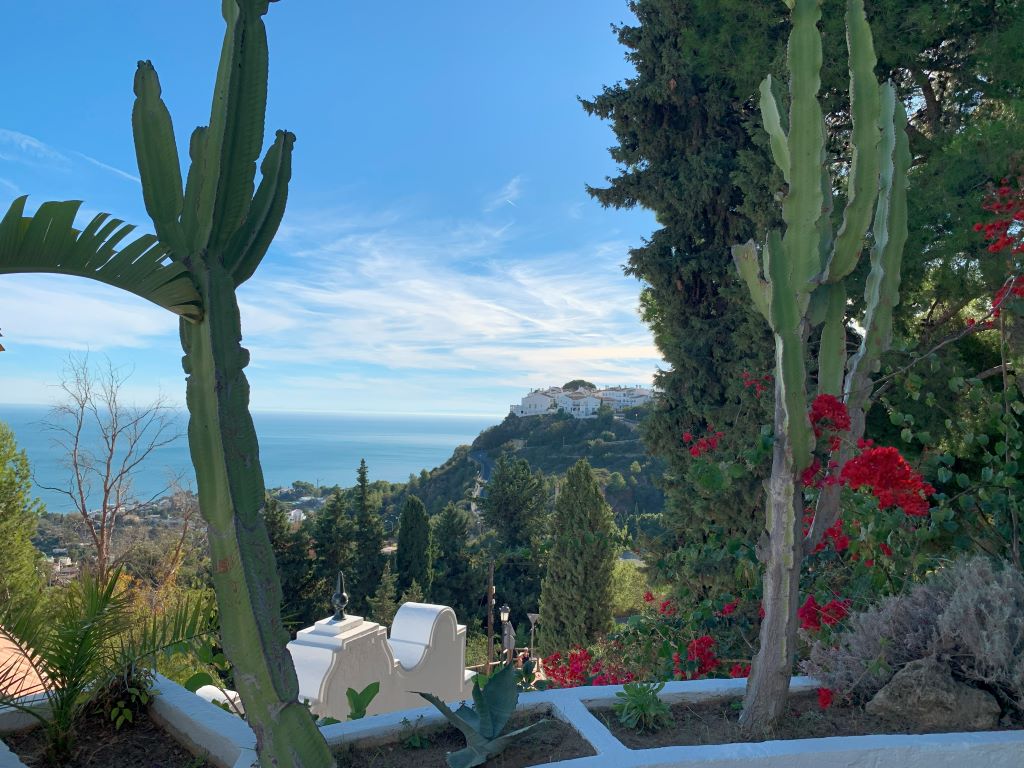
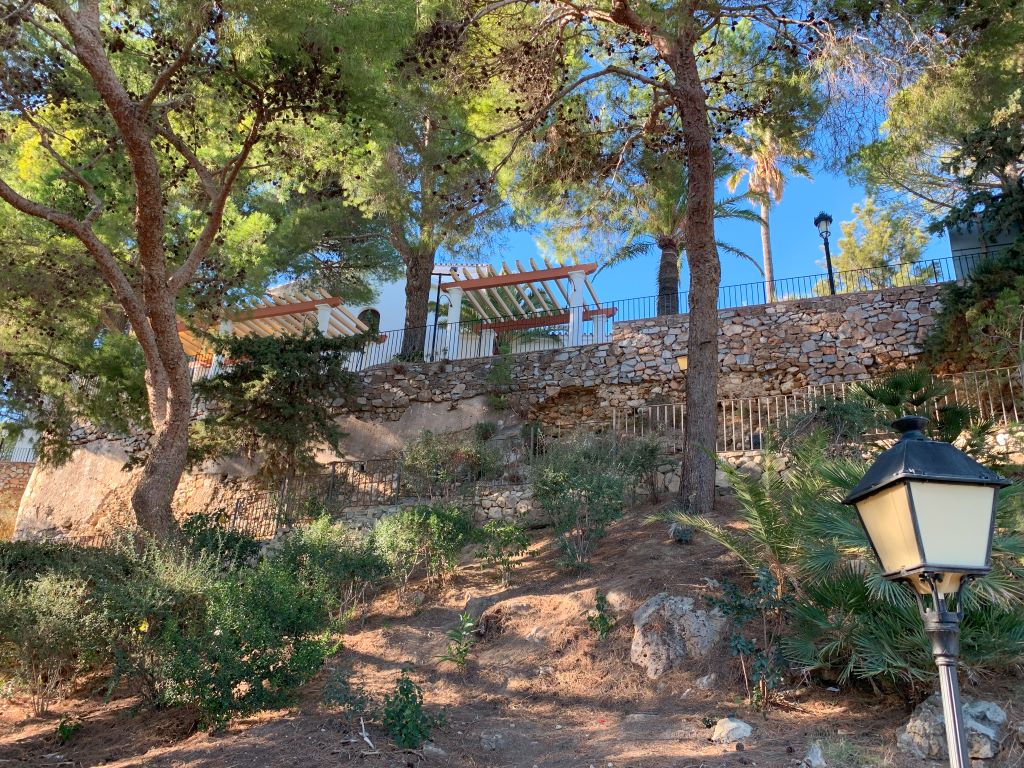
From here we can see the wall that names the place, originally built by the Moors during the time of their occupation.
Back in the upper part of the gardens, there is a small playground behind the church, and ample views of Torremuelle (Benalmadena neighborhood), Castillo Colomares and the Mediterranean.


Castillo Colomares (Colomares Castle)
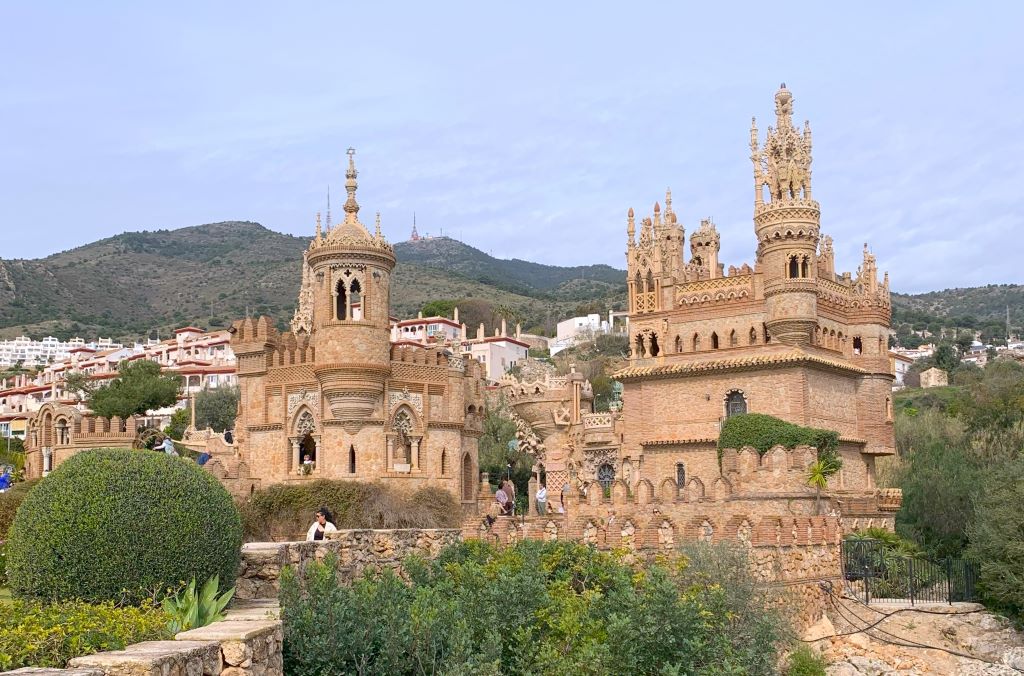
Despite its name, Colomares Castle is not really a castle. It is a castle-shaped (and sized!) monument to Cristopher Columbus (Cristóbal Cólon, in Spanish) and his great adventure through the seas, which lead to the discovery of the Americas and the spread of Spanish people and culture throughout the new world. It is a monument intended to celebrate the genesis of the Spanish world, as proudly displayed in the castle.
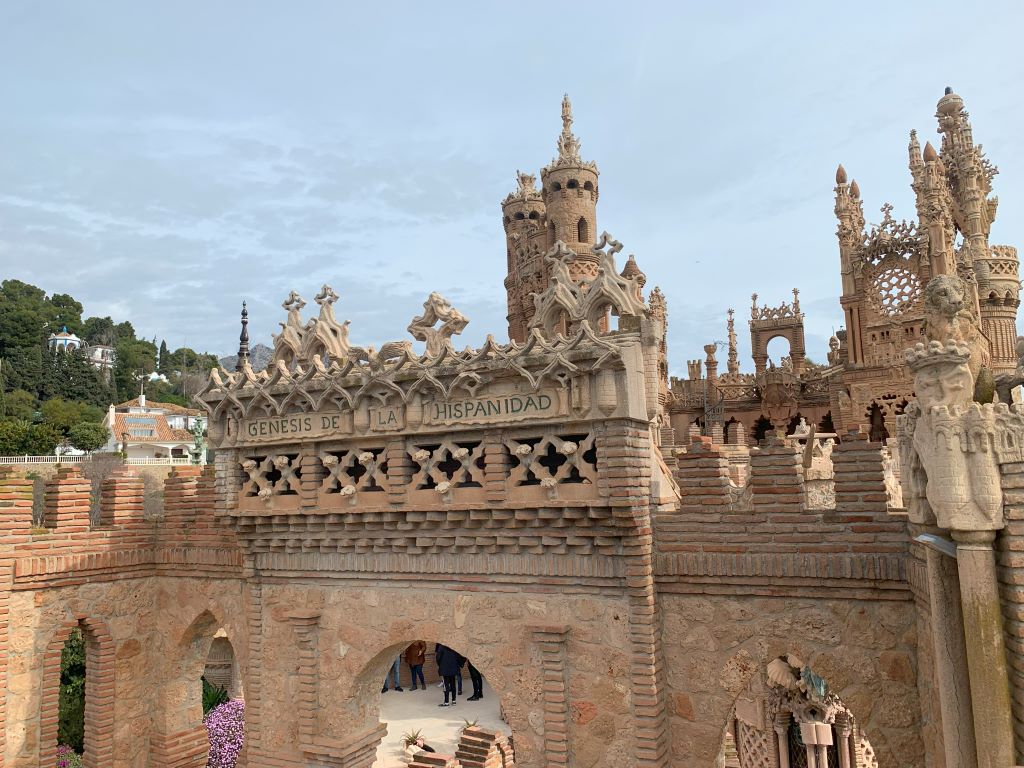
The Colomares Castle is a highly detailed monument depicting the history, hardships and struggles Columbus faced during his voyages, as well as the ships and the context of his explorations. Columbus was originally Italian, but the king of Italy didn’t agree to finance his voyage; it was the king of Spain who saw the potential of the endeavor and agreed to build the ships necessary to the expedition. Columbus departed from Palos de la Frontera (Huelva province, Andalusia) with 96 men, mostly from Andalusia, to discover the new world.
The voyage was successful, as we know. Columbus traveled for two months and reached the new continent on October 12, 1492. For Spain, this achievement is so important that Spain’s National day is October 12th. The castle aims to tell this story as a live book of history, a place to see and walk through the major accomplishment of crossing the world and expanding Spain through a whole new continent.
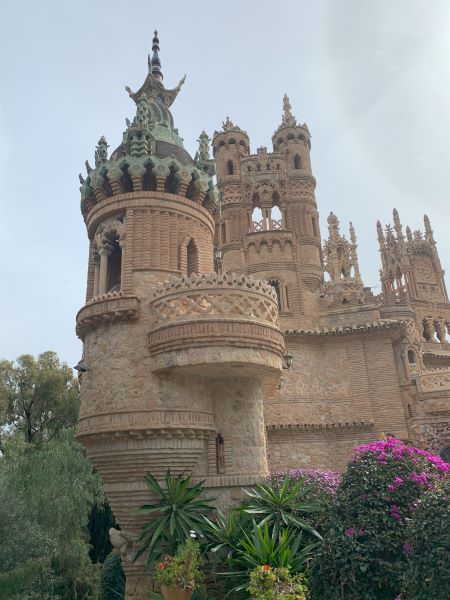
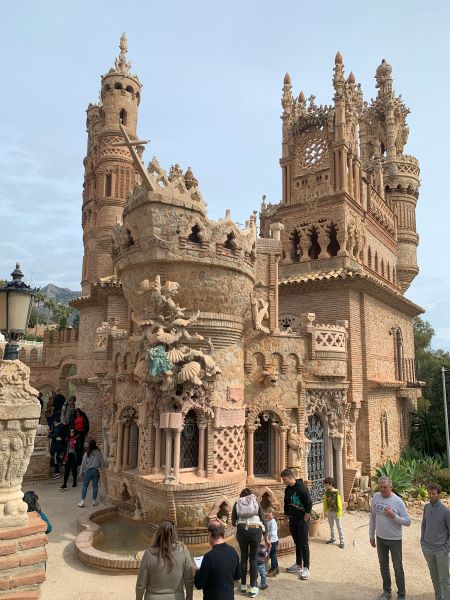

Colomares Castle is a must-see. It is cultural gem, a monument to tenacity, entrepreneurism, courage, and vision, plus a story-telling castle. You can get tickets directly at the entrance – as of today, it costs 3 euros for the general public, and 2 euros for kids and pensioners. You can check opening times at the Castillo Colomares page.
Butterfly Park – Mariposario de Benalmadena
The Butterfly Park – Mariposario de Benalmadena – offers the opportunity to see several butterflies in their own environment, plus tropical plants and other small tropical animals. There is an educational area, where kids and parents can learn more about the transformation process that leads to a butterfly, and then an area where more than a thousand of them fly around. They can even land on you!

The Butterfly Park is great even on rainy days, as it is a closed building. You can get your tickets directly at the Mariposario page.
Related post:
Butterfly Park and Stupa (bonus: Retamar Rustic Park and Lourdes Cave)
Enlightenment Stupa
The Buddhist stupa of Benalmadena is known to be the biggest stupa in the West. Beautifully nestled in the hills of Benalmadena Pueblo and accessible by bus, this remarkable monument to enlightenment welcomes everyone to contemplate and meditate.
It is 33 meters (108 feet) tall and contains an over 100 square meter (1100 square-foot) meditation hall inside. From the ceiling of the meditation hall up to its top, the Stupa is filled with sacred objects.
As the visiting times change according to the season, check on the page of the Enlightenment Stupa their openning hours.
Related post:
Butterfly Park and Stupa (bonus: Retamar Rustic Park and Lourdes Cave)
Inner streets and plazas
As usual with pueblos blancos, there is a lot to be seen just by walking along the quiet streets. Absorb the traditional architecture and peaceful atmosphere of Benalmadena’s Old Town to find cute little plazas among the winding labyrinth of walk-only streets of the center.




Which is Better: Benalmadena Pueblo or Mijas Pueblo?
Hard to say. They are both great, in my opinion, as you can see from the review of Mijas Pueblo. Both are white-washed villages, with amazing views of the coast, many places to eat, beautiful and well-taken-care streets, with flowers everywhere.

Comparing both, Benalmadena Pueblo is smaller than Mijas Pueblo; it is also easier to access from Benalmadena, Torremolinos or Malaga. The way to Mijas, though, by bus, is an event in itself, as the views are fantastic, setting the mood for a great day. Mijas Pueblo has a gorgeous garden surrounded by old walls, and it also has the cute Hermitage of the Virgen de La Peña; Benalmadena Pueblo doesn’t stay behind, as it has the views from the jardines del Muro, the outstanding Castillo Colomares, the Butterfly Park, and the Enlightenment stupa. Benalmadena Pueblo is about 200m above sea level, while Mijas Pueblo is about twice that.
There is no wrong choice here – they are both great, and I’m sure you won’t regret visiting either! Visit both if you can and like to enjoy the easy paced life of a small pueblo blanco with great views and stops to sip and eat something on a terrace. They are also (both) great places for shopping for unique gifts to bring back home.
Are there festivities in Benalmadena Pueblo?
Yes! There are many throughout the year. During festive days, Benalmadena Pueblo gets even more beautiful. The main ones are:
Corpus Christi
In June, a long carpet of flower petals is laid on Calle Real, on the path of the Corpus Christi procession. Visit the town to see this beautiful work of art and devotion!
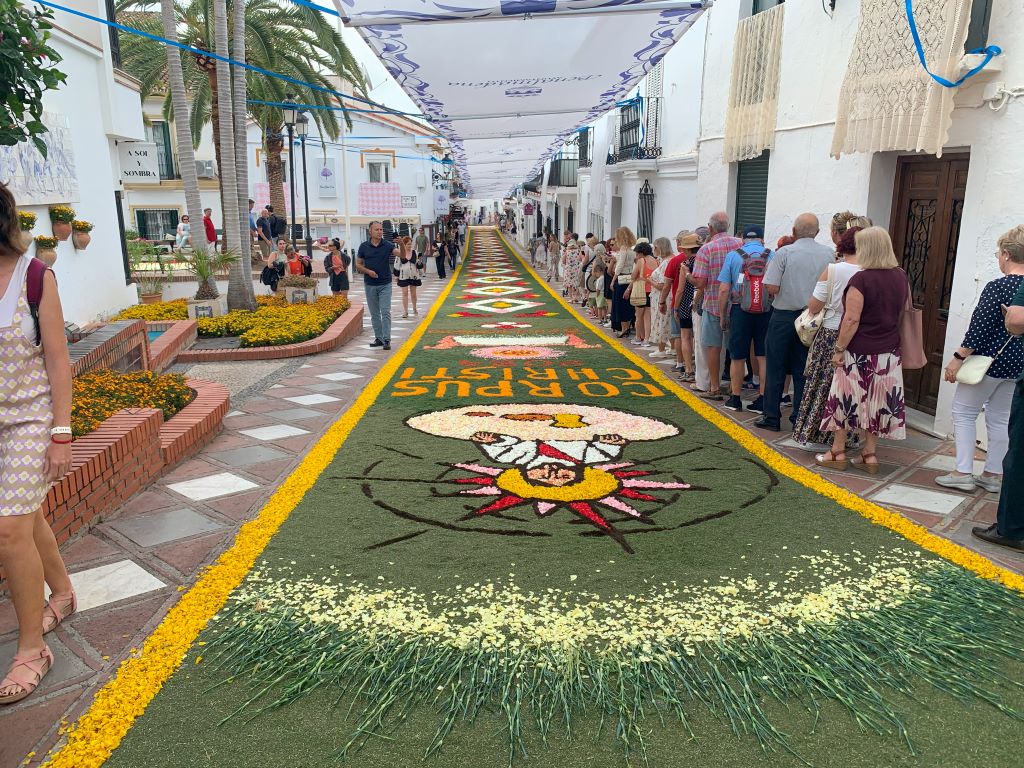
Feria de Benalmadena Pueblo
The Feria de Benalmadena Pueblo happens yearly in August. The town, which is already cute on a normal day, gets filled with flowers and attractions, such as a funfair, parades, workshops, contests, and lots of food! Check here our post about the Feria de Benalmadena Pueblo in 2024.
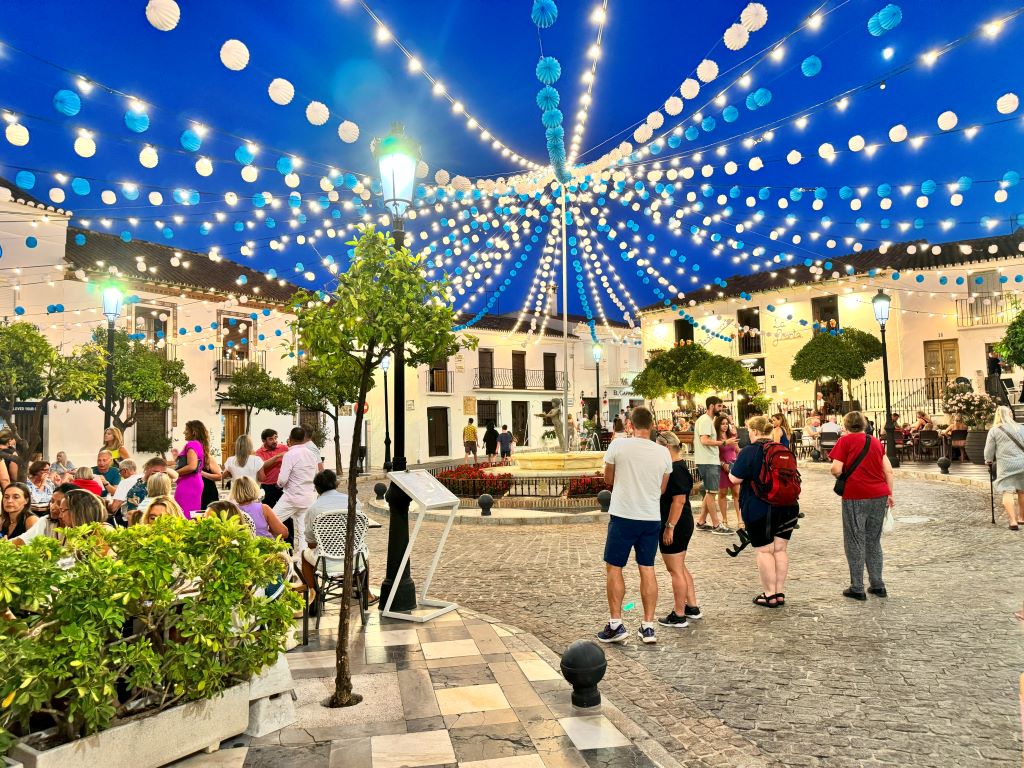
During the Feria, there are events happening in several places of Benalmadena Pueblo at the same time, but the core part is located in the Recinto Ferial, which is used as a parking lot when there is no major event going on. Calle Real, Plaza de España and the gardens around the Church are also main spots during this festivity.
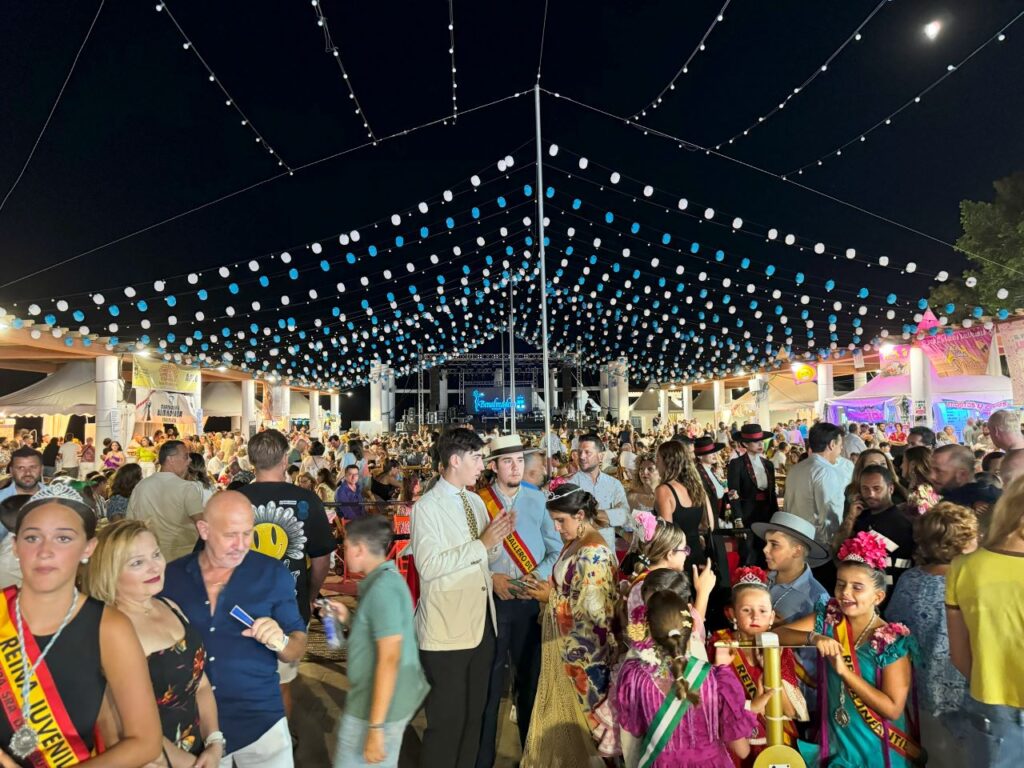
Zoco Árabe (Arabian Market)
In the end of August there is the Zoco Arabe, or Arabian Zouk, with traditional dance, music, sweets, food and drinks. A delightful event that happens mostly in the area along the Calle Real, Plaza de Espana and Church of Santo Domingo de Guzmán.

Halloween
The Halloween is also a big deal; in 2023 there was a calavera parade, made in association with the Museo de Arte Precolombino Felipe Orlando; you can expect a haunted house as well, and more parades for the years to come.
Christmas
During Christmas, the streets of the pueblo get filled with beautiful Christmas lights, some of which were already being installed in November, when many of the pictures in this post were taken.

How long and where to stay in Benalmadena Pueblo?
To see the beautiful streets and enjoy the cafes, one day should be enough; but if you want to enjoy Benalmadena Pueblo longer and also visit Castillo Colomares, the Butterfly Park and/ or the Stupa, then reserve some 2 or 3 days. Benalmadena Pueblo has great hotel options, and for way less than charged in the coastal area.
My favourite is the Boutique Hotel Pueblo, which besides being a well-reviewed hotel qualified as superb on booking.com, is also one of the pueblo’s postcards, perfectly located on Avenida Juan Luis Peralta and right by Calle Real.

Here you can find a few more options of places to stay:
How to get to Benalmádena Pueblo?
The train doesn’t come here, so our options are either car or bus. If you are coming by car, you can park for free in the Recinto Ferial, if there is no event happening, or in other public parking lots, such as the Montebello parking lot, shown below:
A little curiosity about Benalmadena Pueblo is that part of its main road, the Av. Juan Luis Peralta, is narrow enough for only one car. For this reason, there are two traffic lights, one in each extreme of the narrow stretch, which allows cars from only one direction at a time.
Getting to Benalmadena Pueblo by bus is probably easier than by car, especially if you are already in Benalmadena. To visit the city, get off the bus at the stop called Benalmadena Pueblo, or in the next one, Las Mimosas, which is ideal to go to the Castillo Colomares. For the Stupa and the Butterfly Park, leave at the following one, called Estupa Tibetana.
Here are the bus lines that can get you to Benalmadena Pueblo:
From Arroyo de la Miel
Get the 103, 112, 116, 121 or 126 bus by the train station Benalmadena-Arroyo de la Miel, or check the routes in the Consorcio Malaga page (or app) to see if there is a stop closer to you. This bus ride takes 16 minutes, and is beautiful, going above in height, with great views and some peeks of Benalmadena.

From Benalmadena Costa or Torremolinos
Take the 112, 116, 121 or 126 bus that goes along the coast. Check the routes in the Consorcio Malaga page (or app) to find the nearest stop to where you are staying. If you are in Torremolinos, depending on where you are you may prefer to follow the next suggestion:
From Torremolinos, Fuengirola or Malaga
Get the train to the station Benalmadena-Arroyo de la Miel, then follow the instructions as from Arroyo de la Miel.
From Mijas Pueblo
Get the bus line 112. Check the routes in the Consorcio Malaga page (or app) to find the nearest stop to where you are staying.
Transportation tips
Tip 1: buy a bus card from a tabacaria (Tobacco shop). The card gives you a considerable discount on buses of the Consorcio, and has no expiration date, so you can keep it for the next time you come 😉
Tip 2: Check on google maps the easiest way to get from where you are to Benalmadena Pueblo. It will help you find the closest bus stop to you. More on that here.
Conclusion
Benalmadena Pueblo is an Andalusian beauty. A mix of charming village with cultural gem, traditional architecture and panoramic views. A must-see place that is prone to enrich your travel experience. It is completely worth visiting, no matter what time of the year you are around. It is not only worth visiting, it is probably going to be the highlight of your trip. 😉
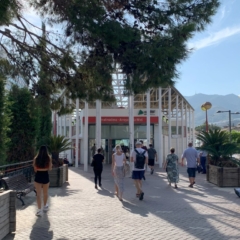


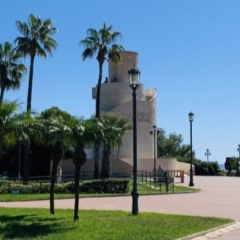
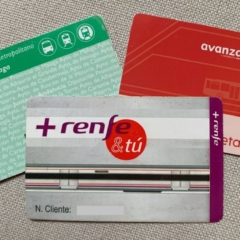
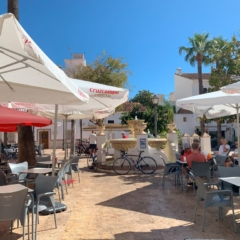
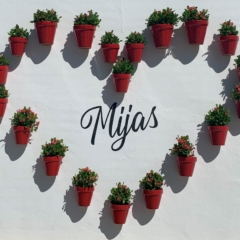
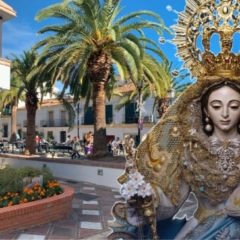

What a wonderful commentary about this area ,& much detailed information ,which I’m sure will help many people visiting this Area
Thank you for taking the time
Thank you!